20 Essential Herping Equipment
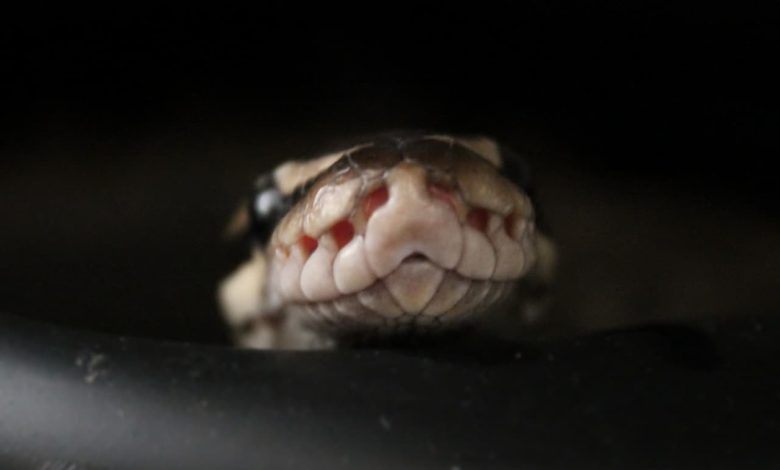
20 Essential Herping Equipment (Equipment & Techniques)
I’ve been herping in Thailand for 15 years. I go 20-30 times a month during the May-August months and usually two to four times a week during other times of the year. During December – March the air and humidity aren’t perfect for finding snakes during herping field trips, but we nearly always find something cool to gawk at.
Also during this time, there isn’t the abundance of lizards, geckos, and other critters that we’re used to during the rainy season.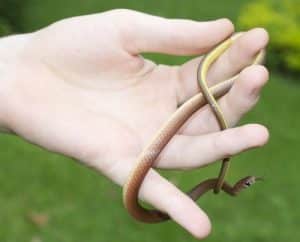
Herping is something I do for fun, a hobby, not a career – so, I go when I think I’ll enjoy it. In 2016 and 2017 I have herped more than I ever have – and my snake count – whatever that is – would show it. Sometimes I wish I kept a log of every snake found.
I started it and stopped after 200 some snakes. I stopped because it sort of takes the fun out of it. I start thinking about number of snakes, rather than focusing on snakes I haven’t found yet that would be more interesting to find than one of the more common snake species In Thailand.
The following is how I go about herping in Southern Thailand. If there is anything else you’d like to add, do so in the comments or send me an email.
THAILAND SNAKE BOOKS
You’ll need a couple of books that will help you get through your Thailand herping with the best experience possible. I have 2 books you can make do with – one of them is essential.
That’s this one:
Is That Snake In Your House Dangerous? Identify Deadly Thailand Snakes Within 5 Minutes! I wrote this one. This is in PDF format and has the 35 deadly terrestrial snakes of Thailand in detail and in high-resolution images. There are ESSENTIAL FIRST AID Instructions included.
Some snakebites need to be wrapped with an elastic bandage, and some don’t – you’d do m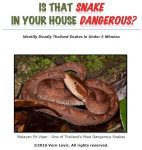
GET THIS BOOK, REALLY IT IS ESSENTIAL if You’re doing ANY Herping Tour in Thailand > Click HERE to GET IT!
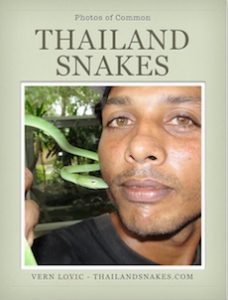
Photos of Common Thailand Snakes! Venomous and non-venomous snakes listed. Photos and facts. This is FREE, and while not essential, it can be the source of some good basic information. You should get it – it’s helpful! > Click HERE to GET IT!
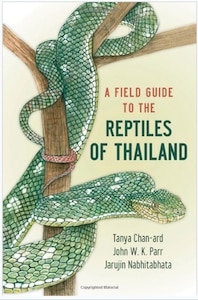

A Field Guide To The Reptiles Of Thailand. This one is available as a MOBI file. You can get it on Amazon here. Yes, it’s expensive, but it covers nearly all the reptiles of Thailand, and it’s fairly comprehensive with not all that many mistakes. It definitely has some.
This Reptile guide doesn’t mention which snakes are venomous and which are not while looking at individual species. They do list it in the general comments about the genus before each group. The hand-drawn images are sometimes incredibly accurate, and other times poor (B. jaspidea image is useless for instance.). Of all the books and ebooks I have, this one is the most comprehensive. It still has errors, but every book I’ve seen has some. > Find here .

Venomous Snakebites and Near Misses!
More than 34 stories of venomous snakebites and very near misses from Southeast Asia’s most deadly snakes – King Cobra, Malayan Pit Viper, Monocled Cobra, Banded Krait, Malayan Krait, and more! Digital Book with over 100 pages by Vern Lovic. Find here.
Herping Boots
If I will be walking in high grass or thick brush, or on deep leaves, I wear simple $6 rubber boots that go above the ankle. These boots cover half the shin – and this seems to work well. The real danger for looking for snakes at night in Thailand is the Malayan Pit Viper.
The worst snake you’d likely be bitten by in Thailand is the Malayan pit viper, or if you’re in the Pattaya or Central Thailand areas – the Russell’s Viper (Siamese viper). Russell’s would maybe go through that rubber. I doubt it, but they do have a strong bite and large fangs.
Monocled cobras are dangerous, but the boots would negate most bites. They have short but strong fangs, but I couldn’t see them penetrating boot rubber.
I don’t walk through any thick grass that blocks me from seeing my feet, or around my feet. If you’re planning on doing that – you should wear the thick rubber boots, or thick leather boots that go almost to your knee.
HERPING PANTS
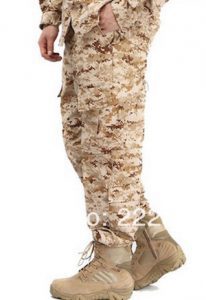
In the past, I’ve worn U.S. marine camouflage pants I bought at a local market. They are real marine issue – very tough material. They were 950 THB ($30 USD). They have a drawstring on each leg that tie at the bottom tightly – and this keeps the ants off my legs.
I pull my socks up over the pants to help as well. Ants and termites are often active at night by the millions.
A Malayan pit viper or Russell’s would bite through the marine pants, no doubt, but the pants would help mitigate the bite and maybe keep it from being a full-on intramuscular injection. I feel a bit safer with the pants, but that is probably just psychological and they probably offer little protection from snakebite at all.
If I’m not going to be walking in high grass or brushing against bushes or other greenery, I’ll wear my Columbia all-weather Cargo pants – these. These pants are water resistant, nylon, and they have SPF 50 sun protection.
Quite nice for the hot climate, keeping the bugs and sun off your legs, and MUCH cooler than those marine pants above.- Find them here. I paid $100 USD here in Thailand at an outlet mall. They’re much less at the link above. If you want the zipper-shorts – long pants you can remove the legs and turn into shorts – they’re here.
Be aware that if you have large thighs – you won’t fit in the zipper-shorts pants. That’s why I got the regular long pants without zipper – they give more space in the butt and thighs.
RAINFOREST HAT
I wear a wide-brimmed hat to keep mosquitoes off my head. I wear a long-sleeved very lightweight running shirt that wicks away sweat – and also keeps the mosquitoes off. They still bite through so I sometimes spray the outside of the shirt if mozzies are thick. A hat with a flap in the back to keep the bugs off your neck would be good. 
If not, I spray the back of my head and arms with mosquito spray (DEET 98). If I don’t spray it, I wrap a large snake bag around my neck like a scarf to keep the bugs off. Keep in mind, if you use bug spray, you cannot handle a snake with your hands, let it crawl on your arms – or wherever the spray is. It’s strong stuff. Here’s one that looks like the same style – Find here.
HEADLAMP - FLASHLIGHT - TORCH
Flashlight technology has exploded. I currently use a horribly expensive Petzl Ultra Rush headlamp. Before that, I used a Petzl Tikka RXP rechargeable headlamp which works at 1.5 hours at full brightness on manual. I also sometimes use my Petzl Nao+ (Plus) headlamp, or the Petzl NAO 2 which also gives about 1.5 hours at full brightness, or 3-4 hours on auto-reactive mode.
All of these lights work well – but the Ultra Rush is just awesome – the beams are just right and the best brightness level for finding wildlife at night. Ultra Rush – Find here. My second choice is also a Petzl headlamp called the NAO+ It’s lightweight and almost perfect – Find here.
Recently I reviewed a new light, the OLIGHT H2R Nova Cool White option – and I like it a lot. It’s priced well below the Petzl lamps and the beam shape and color are also pretty ideal for finding wildlife at night.
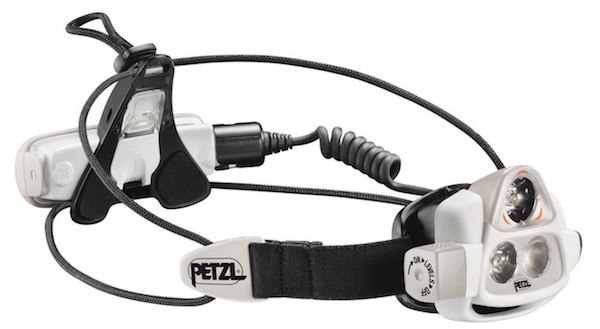
I have a couple of Fenix HP 25 headlamps which have a too-bright center beam and weak flood light beam – so they’re less than ideal. Recently I was able to review the Fenix HL60R, and it’s quite good.
There are advantages to a light like this, but I didn’t like the quality of light it puts out for herping. It’s quite orange, and for some reason, the contrast of snakes against leaves and dirt – is weak. I find many more snakes with the Ultra Rush, so I’ll never go back to anything else.
The HP25 is good for spotting snakes and lizards very far away with a small (tight) beam when road cruising. I also have a handful of UltraFire handheld flashlights with adjustable beam. Wider beams are best for herping, a tightly focused center spot beam can hurt your eyes before long.
My flashlights put out around 250 lumens. My headlamps are all over 300 lm. You can buy either cheap Chinese flashlights, or good lights with 500+ lumens these days. The more light the better, but take caution with never shining the full brightness of your torch into an animal’s eyes.
The 18650 rechargeable batteries are amazing, but at full power – one will last about 1.5 hours, depending on how many lumens your light is cranking out. I bring many spares.

If you get a headlamp, try to get one that also accepts readily available AAA or AA batteries in an emergency when your rechargeable batteries fail. Be careful about buying cheap rip-off 18650 batteries made in China or elsewhere which will lose their charge in a very short time over a couple of weeks or months. I have a bag full of them.
I find the silver Energizer batteries you can find in the ‘Big Camera’ stores in Tesco or Big C, are the longest lasting. They are also cheaper there than in Tesco Lotus.
If you want the absolute ultimate herping headlamp – I can’t recommend anything stronger than the Petzl Ultra Rush. Update – a new Petzl is coming out and it will be about the same cost, but even more functional as it has different style beams.
I ordered one and will review it at my Headlamps101.com site in a few days.
SNAKE HOOKS - SNAKE TONGS
I bought snake tongs on EBay. The brand is Midwest and sold at Tongs.com, but they don’t ship to Thailand. Some guy on Ebay had them and sent them to Thailand for me. Cost was $110 USD + $45 shipping. I also bought snake bags from him.
I use tongs ONLY for grabbing snakes out of trees gently. Once they are on the tongs, I just balance them on there and pull them down to the ground. Tongs are insidious for causing snake injuries – broken ribs being the big problem. Learn how to use them gently, or don’t use them at all.
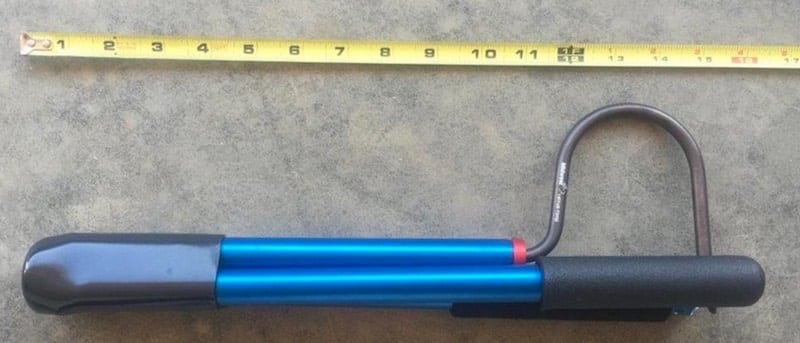
To craft a snake hook I bought two metal paint rollers, took them apart, and had someone weld them together in a makeshift hook. Total cost is about 250 THB ($8 USD). I was never a fan of $30 hooks, until Al Coritz (ViperKeeper) gave me his awesome Midwest 3-piece collapsible hook! Thanks Al!
Then I made another with a 3 iron golf club and had a metal shop worker bend the hook to the right dimensions. It worked well and cost just $5 here in Thailand.
Here is a popular quality one on Amazon:
- BALANCED – a unique copper ferrule allows for a lighter, more balanced hook without compromising strength.
- RUGGED – materials like copper and stainless steel combine to make a tool designed for real work.
- SAFE – a secure rubber grip, light weight and hook geometry allow you to safely catch, control or move reptiles.
- BEAUTIFUL – a high level of craftsmanship and attention to detail result in a hook that’s a pleasure to use.
- RELIABLE- a professional tool crafted in the USA and built for many years of reliable use.
Handling Gloves
Leather Animal Handling Gloves, Multipurpose Pet Glove for Grabbing Reptiles, Grooming, Trips to the Vet.
Puncture & Scratch Resistant, Bite Proof for Cats, Dogs, Birds Falcons Livestock & Snakes.
Leather Animal Handling Gloves are made from 1.2mm thick shoulder split natural cowhide leather which is the Top Grain Leather.Reinforced double leather Finger Palms & Backs and high strength Kevlar sewing ,provide an excellent bite-proof function from small animal for your hands and Forearm. The 23.6 inches extra long glove protect your Fingers and Forearm from Animal bites
SNAKE HOLDING BAGS
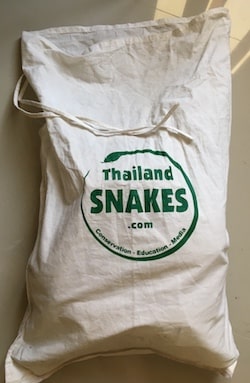
I had some large meter-long and half-meter-wide bags made using some strong fabric I found at the store. They are double-stitched and strong. I like big bags rather than small ones. I have a ton of small bags Al Coritz gave me, and I also use Tongs.com bags as shown above.
They’re good as any. I do wish they had some black bags. I’m frequently alone and it’s tough to get a snake to crawl willingly into a white bag. I usually just shoot photos and videos of the snakes I see on-site.
Occasionally I want to get more/better photos, in pouring rain for instance. I’ll bag the snake and keep it overnight, shooting the next day, and letting the snake go in the same place I found it that next night.
Recently I made some bags here in Thailand. I have only a couple left. They’re large – a meter long by .5m wide. If you want one, you can send $14.99 by PayPal to: https://paypal.me/AIDORG/14.99 and then email me to let me know your address.
If I get a few orders, I’ll have some more bags made, so you can order multiples if you want. Just use https://paypal.me/AIDORG/22 for 2 bags; https://paypal.me/AIDORG/29 for 3 bags; https://paypal.me/AIDORG/34 for 4 bags; https://paypal.me/AIDORG/39 for 5 bags.
KNIFE
I carry a Gerber folding knife with 4-5 inch blade or a Ka-bar. There are bears where I go herping, wild cats, and large pythons. I am over-cautious and always like to have some sort of weapon on me. I envision getting bitten by a 5-meter python and then him wrapping around me quickly – and dying there in a few minutes. No thanks!
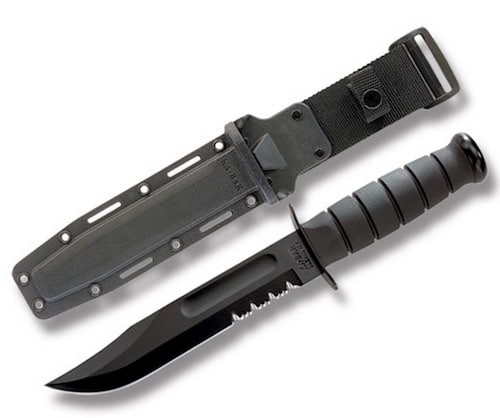
With the knife, I’d try my damnedest to cut his head off before he wrapped around me. A wild cat I’d have some kind of chance against. With a bear, I’d just run fast and climb a tree and hope I could jump over to another tree if he followed me up it.
Thailand has both the Malayan Sun Bear and the Asiatic Black Bear. These are supposedly two of the most aggressive bears on the planet, but I have yet to hear of anyone being attacked. They roam around the big national parks up around Bangkok, Chiang Mai, and anywhere close to Burma.
Just be aware, and have some idea in mind what you’ll do if you see one. So far I’ve not seen any bears, but I’ve seen some leopards, big pythons, and some smelly hog badgers. I have the exact knife above. Find here
MOSQUITO SPRAY
Pump spray bottle with DEET 98 or at least 50 – the highest number you can get. For the last few years I’ve rarely worn any spray. I don’t like to get the chemical on me because I pick up a lot of snakes – and you can’t do that if you have the chemicals on you.
CAMERA
I usually bring a GoPro 5, iPhone, and one of my DSLR’s. The Nikon D500 is on the way. I’ve started my official Wildlife Photography Courses over HERE if you’re interested.
If you’re wondering which DSLR to bring, I have used the Nikon D610 for a couple of years of macro photography and videography in the rainforest at night. With the D610 I use a 100mm micro (2.8F) lens. I know, it’s macro.
Nikon for whatever reason has always called them microlenses. I also sometimes bring a 35mm F/1.8 lens for wide-angle video shots. For a flash diffuser, I wrap a dry baby wet-wipe around my flash in 2-3 layers and secure it with rubber bands. I shoot at 1/250 and F/16 usually around 800 ISO.
Recently, I sold the Nikon D610 and I’m looking at either using my iPhone for everything or going all in on a D850 or maybe a D500.
MOBILE PHONE
You should always bring a charged mobile phone with a Thailand SIM card. Before you go out at night make sure you download a flashlight app that will allow you to use your flash as a flashlight in an emergency. Some apps will give you more light than the supplied flashlight app your phone probably already has. Try a few out and get a bright one.
BEST TIME TO GO HERPING IN THAILAND?
I see some snakes during the daylight hours, and it’s very difficult to walk around looking for them during a hot day – or any day because there is just too much diffuse light – no contrast. I prefer the night herping by far.
Some snakes are active right at dusk, others not until 10:00 PM, still others not until after midnight. I tend to find cat snakes (Boiga cyanea, B. cynodon) from 11:00 PM and later. I find mangrove cat snakes (Boiga dendrophila) begin to get active around 8 – 9:00 PM, cruising up along the edge of streams. Pythons – after 11:00 PM.
Malayan kraits – juveniles right after dark and adults after 9-10:00 PM, they crawl along the edges of hills, sidewalks, rocks.
Best months to do a Thailand herping field trip? April (sometimes) but usually May to December – as long as the rains are continuing every couple of days. The best time to go is any time after a rain, and when it’s warm (over 28°C), humid, and not windy. Moon phase seems to matter for some snakes, but for others – they don’t seem to care.
HOW TO LOOK FOR SNAKES?
I walk slowly around, looking at everything in the area before moving forward. I look on the ground in front of me before I step – every time without fail. Malayan pit vipers are common and have horrible bites. I don’t ever want a bite from that snake.
I look at the trunks of palm trees and the whole way up. I look along the edges of things… rocks, sidewalks, where the grass meets dirt, edges of puddles, ponds, streams. By walking and stopping I can listen closely for any movement. The movement of a lizard, skink, gecko, or anything, can also signal the presence of a snake following it, causing it to move.
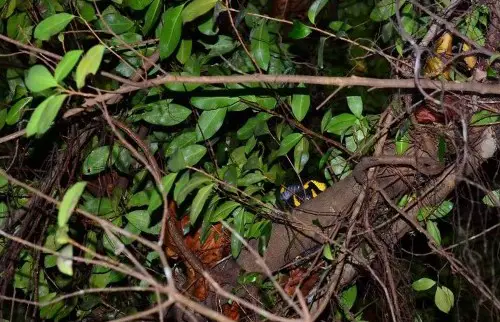
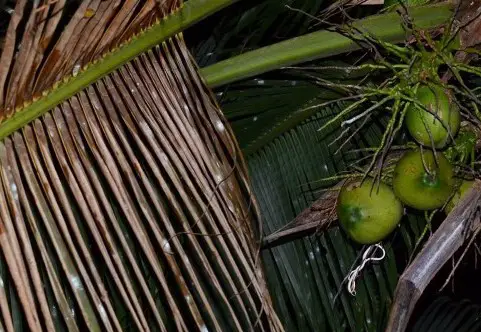
Some people enjoy looking in the trees. It is too detailed for me and I can only do it for a short while before I find myself looking on the ground again. I look primarily on the ground in areas with big trees. In areas with many ground bushes, I will look there too.
Snake scales show up well in the beam of the headlamps. At night, many snakes that are active by day are sleeping in the branches of bushes with some cover. Some snakes (Ahaetulla prasina, Oriental Whip Snakes) are found sleeping on top of branches or leaves.
Some of the larger day active snakes are easily seen in trees at night because they have such a big ventral area that reflects back.
ROAD CRUISING
If it’s raining or has just rained, and the herping where I am isn’t very productive, I might jump in the car or on the motorbike and go drive the country roads to look for snakes. In Thailand this is very productive at night during or after rain.
Why? Frogs, geckos, and skinks are often found on the roads too – snakes follow them.
THAILAND SNAKE HERPING CAUTIONS
I’ve not been bitten by any venomous snake in the ten years I’ve been catching them. I’ve never seen anyone get bitten by anything venomous. I am very careful about handling them, but really I handle snakes very little.
I will tail something, but I hold a venomous snake by the head only to show someone the fangs occasionally. There’s no reason to do it every time, I’m not milking them, nor am I force-feeding them. I’ve noticed that the couple times I was nearly bitten, I either did something stupid, or there was an accident which I couldn’t have predicted, which almost got me bitten.
One time I was holding a Malayan Pit Viper on a stick (didn’t have my hook or tongs), and I was going to flip him out away from me. I was holding it about waist high. As I went to flip him out – the end of my stick caught on a bush branch and at the same time – he struck at me, came off the stick, and landed closer to my feet than I would have liked.
He wasn’t ready to strike again and I was probably still out of range, but, lesson learned.
Another time, I was trying to get a Mangrove pit viper to move faster to get into the mangroves because some monkeys were coming and showing interest in him.
I was standing on the mud with him, his head was a meter away from me and looking the opposite way. I kicked his tail with my sports-sandaled foot, thinking he’d go faster away. Nope. He twisted around in a split second and was poised to strike at my foot. I had been off-balance after I tapped his tail and my foot landed closer to him and with my weight on it. I couldn’t move it by the time he turned around.
He could have tagged me. Really a stupid move on my part. Snakes don’t always go faster when you tap the tail. I knew that, and what I was thinking that day – I’m not sure. Really clear thinking is necessary while looking for snakes – make a note!
Don’t drink alcohol before looking for snakes. It makes you prone to really stupid errors.
So, be careful out there. Ideally you’ll have 2-3 people going at the same time. It’s safer that way.
If you would like to experience a snake field trip of a lifetime – contact us HERE.
Cheers!
Vern L.
ThailandSnakes.com
Thailand Snakes at Facebook
My Thailand Living YouTube Channel (varied wildlife)
Thailand Snakes at YouTube

Hi,
I am going to Phra Thong Island in Thailand for all the month of February and I love snakes. I would like to make some nice pictures of the snakes other there; Could you give me some advice ? like when , where and how to search snakes?
Thank you
Vincent
Hi, sure.
Just get a very strong flashlight or headlamp and walk around at night. Look on the ground mostly – because you don’t want to step on a viper. Look at the trees – palm trees especially for cat snakes crawling up or down. Look for whip snakes sleeping from 1 to 3 meters off the ground in leafless branches. If you can walk near water – that’s better. If you can go during a night the ground is wet and it’s warm – over 29-30C it’s better. Go during June to October for best results. Cheers!
Hi,
Vern I just stumbled upon this website researching herping in Southeast Asia because I am going there with a buddy’s family (may 15-june 15ish) and wanted to sharpen up my knowledge in the area so that I can be the most successful. I’ve already decided to buy two field books one of them being the one by Merel J. Cox…heard the best things about this one. I’m a seasoned and very knowledgeable herper and have found most herps in the state of Colorado and some others from various states. Anyways, you can only get so much info from a book and some pictures, so I would really love the chance to pick your brain and possibly get out in the field with you when I’m there. Don’t know exactly where I’ll be, but I do know I will be around Bangkok for some days and in the southeast fairly close to the borders of both Cambodia and Laos. There’s also very good chances I’ll be visiting the north part of the country and the south down the peninsula.
Thanks,
Ty
Hi Ty,
I may be available to go out when you arrive. I live in Krabi. Let me know a few days in advance before you get here. Do you have a website about snakes?
I do not have a website about snakes but you can check out some of my photography of some of my work on photobucket. I will let you know a few days ahead of time and I should have a real good idea of exactly where I’ll be at during my stay by that time. It’ll just be my thai friend and I who has family from the Sisaket province so we’ll be pretty flexible on traveling money permitting however.
Love your website…great and accurate info.
I am a photographer and currently working on a photo-docu about rice-cultivation. Love to walk around in the paddy-fields.
There are always lots of beautiful Chine White crane birds around. To shoot them I need to lay down to keep myself out of their peripheral sight. Is this dangerous?
Could you give me any advice on the dangers of snakes in the ricefields?
Much appreciated
Sincerely,
Felix
Maybe dangerous depending how long you lay down there. When you’re first hitting the ground, assuming you’ve scouted the area – snakes will notice you moving and avoid you. Maybe some will avoid you because of smell. At some point, a snake could investigate your pant leg or crawl over you – but really, unless you’re shooting at night I’d say the chance of bite from a snake coming up to you while you’re laying on the ground for 5-10 minutes, is not high at all. Infinitesimally small, I’d guess. Hope I spelled that right. If you’re laying there for 30 minutes? Risk goes up a bit. The Malayan pit vipers and the cobras – including the spitters – are the snakes you might encounter someday. (guessing)
Vern,
I think you should edit this post to refer to your new book in addition to (instead of?) the books you refer to now. Bought the book and it is quite interesting. Going to be with me on my next photography outing.
Tony
Thanks Tony – I’ll do that. Cheers man!
I do all my herping in Khao Yai National Park, but I’d love to venture down and see what Krabi has to offer. Do you have directions to some good herping spots?
National parks are best
Do you know of any locations in Chiang Mai to get good, high quality 18650 batteries? Don’t want to get ripped off with any of the cheap ones.
Man, I don’t know a good place in the WORLD to get them. I have one in my Petzl Nao headlamp that is AMAZING. It’s only like 3400 mAh but it has worked solid for at least 150 times herping in 2016.
Hi, we are staying at Khao lak from 9/6-17/6. We are very interested in a local herp tour, we are keen herps from Sydney. Can you help us out?
Nothing out there that I know of… I’m sure some Thai ‘guide’ will take you somewhere though…
Hi! I am a student in biology and I come from French Guiana in Amazonian rainforest. I do herping from a long time now and I come in Thailand for July 2023 with a real good herping team. Did you have any good info on productive spots outside national parks? We think to go in Kaeng Krachan for some nights but we also want other free spots for herping how we want without guards etc.
Hi,
I don’t recommend you come to Thailand with no experience and try to herp here. What will you do about dogs? What will you know about treating venomous snakebites from our snakes here? What will you know about the hospitals that have antivenom? What do you know about handling the snakes here?
Stick to the national parks and you’ll have less dogs and they may be able to help if someone is bitten and you need to get to a hospital.
Cheers – good luck